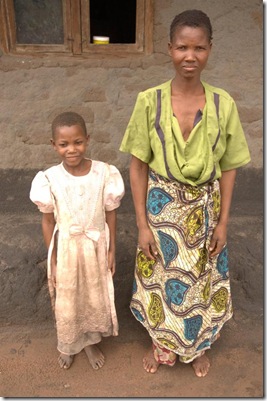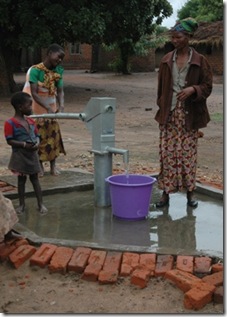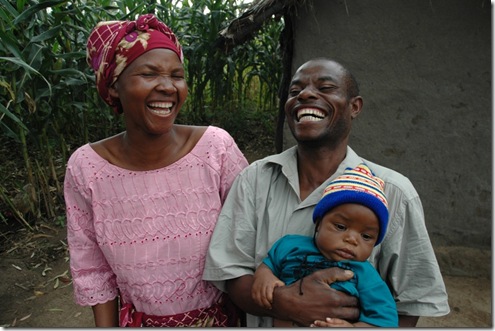This post is one of many participating in the Day Without Dignity initiated by the Good Intentions Are Not Enough Blog. Follow the link to learn more about what people are saying, and the controversial TOMS ‘Day Without Shoes’ Event that sparked these discussions.
A few years ago, Fonase Banda, of Chikandwe Village, Malawi, was photographed with her daughter Milika by a major INGO. At the time, the two were told that the INGO would arrange for Milika to have a pen pal with someone internationally. The connection with the pen pal, however, was never made.
When I talked about this with Fonase and her husband Bauleni last year, at the start of the Perspectives of Poverty project, they were quite upset that nothing had happened. “We only see them driving in their trucks, but they do not come here,” they said.
As someone appalled by how rural Africans have been characterized in the media and in fundraising campaigns for INGOs, I began the Perspectives of Poverty project to show the many ways in which people can be characterized through images, and the false conclusions these images may lead us to. I have had the privelidge of living with the Banda family, where Fonase cared for me as a mother. I know her as a reslilient and lively woman, full of character.
The thought of her being characterized as anything different upset me, and I returned to Chikandwe Village at the end of 2010 to include Fonase and Milika in the Perspectives of Poverty project. I wanted to take a photo that resembled the one taken by the INGO as closely as possible – based on Fonase’s description – and contrast it with one of my own photos. But when I arrived, a curious thing had happened: the INGO had come to the village, and installed a new borehole.
Water had been a serious issue in the village previously. I myself had been sick many times while I lived there, I believe largely because of the open shallow well – frequently murky – that we used to drink from. But now the people of Chikandwe had clean water, and it was because of this INGO who had taken the photos previously.
For me, this brought up one of the key issues that has arisen in the discussion about how poverty should be characterized in the media. Some argued that portraits of despair or desperation can play a positive role if they generate funds that are used to do good work. While I agree that the borehole has had a positive impact on Chikandwe village and the Banda family, I question the necessity of undignified images.
And so I put it to you, the reader. Below are the two images of Fonase Banda with different members of her family. The first is a photo taken to resemble, as closely as possible, the photo taken by the INGO. The second is one of my photos, taken to show the true character of this remarkable woman. Both photos show a woman who faces mighty challenges and a woman of resilience and capability.
 Fonase Banda and her daughter Milika, resembling the photo taken by the INGO
Fonase Banda and her daughter Milika, resembling the photo taken by the INGO
Fonase Banda and her husband Bauleni, photographed here with their son Duncan.
The question: is a portrait of despair needed to secure a donation, or to advance good work? Could a more dignified representation have achieved the same thing, or even more?
I look forward to your comments.




[…] Development Without Dignity – Water Wellness […]
By: A Day Without Dignity | Good Intentions Are Not Enough on April 5, 2011
at 2:18 pm
[…] іntο more here: Development Without Dignity « Fill up Wellness Posted in Hosting | Tagged as: controversial, enough, follow-the-link, good-, people-are, […]
By: Development Without Dignity « Water Wellness | Web Host Aid on April 5, 2011
at 9:41 pm
[…] Duncan: Development without Dignity – http://waterwellness.ca/2011/04/05/development-without-dignity/ Jordan: How to screw up Malawian greetings, and other joys of EWB field work – […]
By: Development Digest – 09/04/11 « What am I doing here? on April 9, 2011
at 12:38 pm
I absolutely agree. The images of poverty that most INGOs put out in the media causes more harm than good. Not to long ago we got a bunch of students to list the words that came to mind when they saw these types of photos and then asked them if they are the type of words that would describe people they would want to play and work with. People they would want to be their neighbors.
Be thankful you didn’t have to sit through comic relief in the UK recently. You know they do studies to find out what images get the biggest emotional reaction as so get people donating more?
By: Pj on April 11, 2011
at 9:53 am
I confess, the second picture would be more successful to me as an “after” picture. While disingenuous to say, “See, she was sad before, and now the family is happy and have good teeth” the laughing picture is not one that says “I need your help.” I am worthy of your help, maybe. I am a nice person you would like to help, maybe.
I think you can do dignity and still communicate need. For instance: get the people you picture to sign off on the project. “My name is Fonase and I approve this message.” You could show her in the better-fitting clothes next to the murky water, showing the real problem, allow her to look upset at the poor conditions but dignified.
By: D. Watson on April 11, 2011
at 5:04 pm